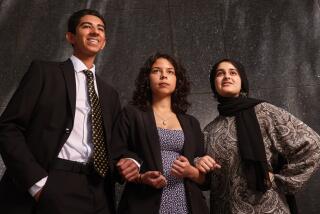Lessons Learned : Schools Get Credit for Holding Teen Smoking Steady
- Share via
Joe Camel sure looks cool, decked out in sunglasses and plastered on billboards throughout the city. But the fictional cigarette company character can bury his butts in the Mojave, as far as Carlos and Luis Basulto are concerned.
The brothers--ages 15 and 10--say they’ve been taught at school what cigarette smoking can do. “We know it hurts you,” said Carlos, who attends Cleveland High in Reseda.
Such classroom lessons are believed to be part of the reason teen-age smoking in California has leveled off in the past three years, while teen-agers in other states across the country are lighting up more than ever. About 3 million teen-agers smoke nationwide.
Carlos and Luis say it was in the classroom, not from television or at home (their father smokes) that they learned nicotine, tar and lung tissue don’t mix, no matter what the Marlboro Man might say.
Educators and activists say California’s anti-tobacco media campaign and education program is making the difference. The program--which includes TV commercials--is funded by a 25-cent excise tax on cigarette packs. The tax, known as Proposition 99, was approved by voters in 1988.
About 19% of California boys ages 16 and 17 smoked in 1990, a percentage that has held steady through 1993, according to a study completed this year by the Cancer Prevention and Control Program at UC San Diego.
The same study found that California girls ages 16 and 17 smoke less than boys the same age. Slightly more than 15% of California girls 16 and 17 smoked in 1990, and only 14% percent of that age group said they smoked in 1993.
Nationwide, about 25% of all 17- and 18-year-olds are smokers, and the rate is growing.
At the Valley Community Clinic in North Hollywood, Reasie Flagg, director of tobacco education, says it’s important to ensure teen-agers learn to ignore peer pressure and resist glitzy cigarette ads.
Flagg uses Proposition 99 funds to pay a group of young actors to perform such plays as “The Trial of Virginia Slimes” at area schools.
“It’s an ‘L.A. Law’ type production,” Flagg said. “We ask the audience to decide whether Virginia Slimes should be held responsible for the deaths of those she persuaded to smoke. We have to make it very corny or the students would feel insulted.”
Dr. John Pierce, director of UCSD’s cancer prevention program, agrees that increased education is the key to neutralizing teen-age smoking rates in California.
“The tobacco tax and the programs appear to be working,” said Pierce. “It’s kept teen smoking in check, and it’s also preventing young adults from starting.”
But cigarette advertising that targets youth often hits the mark, Pierce said.
“With your average 16-year-old, we found they’re smoking one of two brands: Camel or Marlboro,” Pierce said. “That tells us they’re not impacted by the higher cost, or they’d be smoking cheaper generic brands. We concluded that the school-based tobacco education programs are working.”
Cecilia Costas, principal at Charles Maclay Middle School in Pacoima, said students who sneak smokes are rare at her school.
“Our kids are really into doing what’s good for the environment and good for their bodies,” Costas said. “We teach them in class to have self-esteem.”
Proposition 99 funds are also used to send thousands of Los Angeles-area children to a three-day smoke-free camp in Saugus near Magic Mountain amusement park.
Luis Basulto went to the camp this year with his 10-year-old classmate, Francisco Avalos. Both attend Cantara Street Elementary School in Northridge.
“They showed us videos about how smoking affects you,” Francisco said.
“They took us hiking and told us not to smoke,” Luis added. His older brother, Mario, 19, doesn’t smoke either, but said his decision was personal. Mario, who attends Pierce College, said most of his close friends are non-smokers, too.
“The cigarette ads don’t really get to us, I guess,” Basulto added. “California is a relatively healthy state. As a state, we’re not too good at too many things, but I guess if the teen-agers don’t smoke as much as the rest of the country, that’s one good thing.”
Barbara Dietsch, coordinator of the Tobacco Use Prevention and Education program for the Los Angeles Unified School District, said Proposition 99 funds this year are being used mostly for education programs that target students in the fourth through eighth grades.
Some students say they don’t need a corny play or a day camp to help them understand why smoking isn’t healthy.
*
Salvador Morales, an eighth-grader at Northridge Middle School, shrugged his shoulders when asked why he doesn’t smoke, even though his friends do.
“I guess I don’t want to die too fast,” he said.
The impact of teen-age smoking on next week’s vote on Proposition 188--a ballot initiative designed to replace California’s current smoking restrictions with a weaker set of rules--is a matter of debate.
Those who oppose the measure, including the local unit of the American Cancer Society, say it will lead to increased teen-age smoking. But the tobacco industry says 188 would lead to reduced levels of teen-age tobacco use by putting restrictions on cigarette vending machines.
More to Read
Sign up for Essential California
The most important California stories and recommendations in your inbox every morning.
You may occasionally receive promotional content from the Los Angeles Times.













